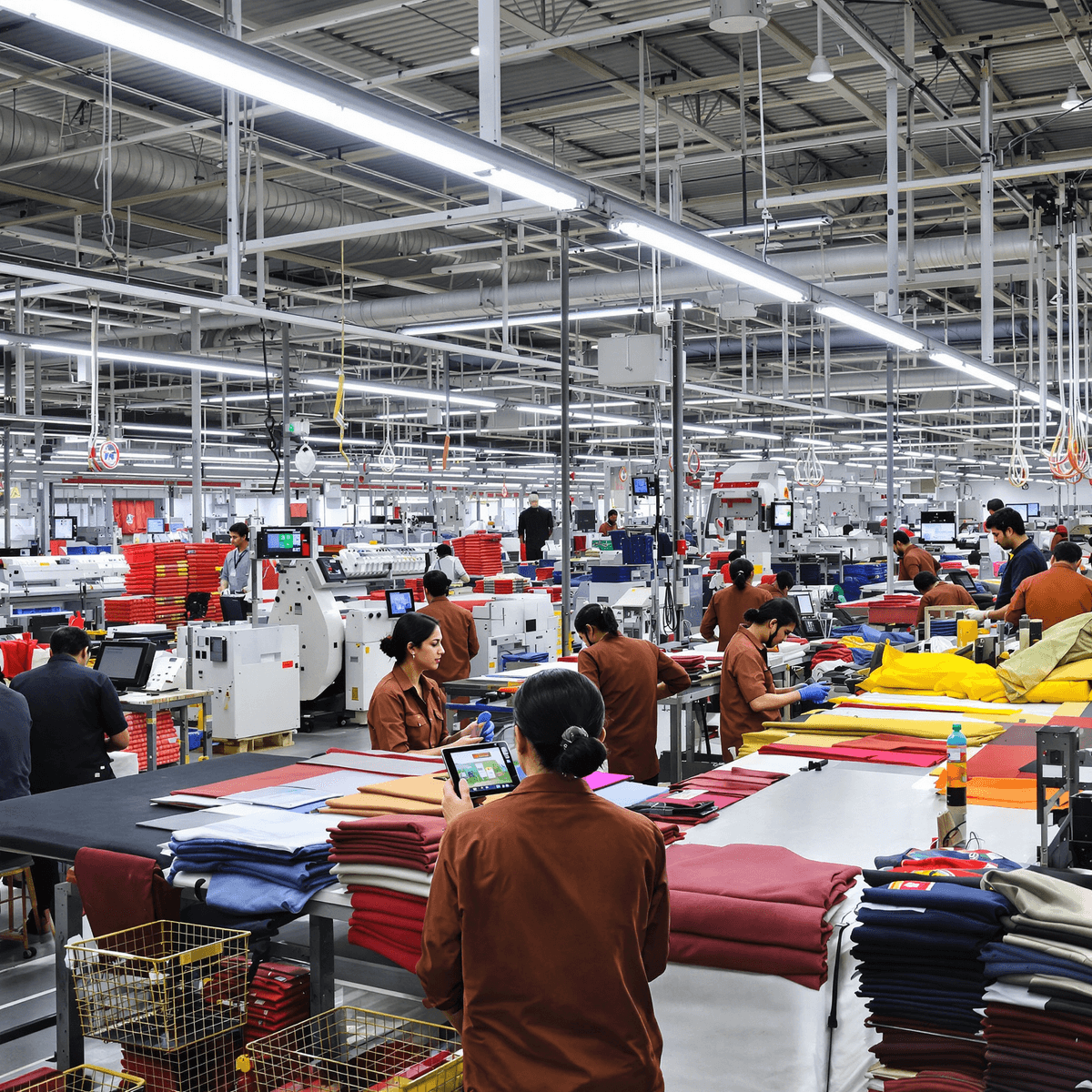From Tailor to Tech: Is India Ready for Online Uniform Supply?

India’s textile industry is at a crucial point where traditional craftsmanship meets modern digital innovation. One important part of this industry, the uniform supply sector, is starting to change from local tailoring shops to advanced online ordering platforms.
The ongoing digital revolution in India’s textile industry has brought about significant changes:
- Smart inventory management systems are replacing manual record-keeping
- Real-time tracking of uniform production and delivery is now possible
- Advanced measurement technologies are ensuring precise sizing
- Digital platforms are connecting manufacturers directly with institutional buyers
However, the journey towards complete digitalization is not straightforward. While metropolitan areas are adopting automated uniform management systems, many regions still depend on traditional methods. This creates an interesting dynamic in the market, with tech-savvy manufacturers competing against traditional suppliers.
To successfully navigate this path to digital transformation, it is essential to carefully consider India’s unique challenges and opportunities. The key to success lies in finding a balance between technological advancement and practical implementation across various geographical and economic segments.
The Role of Technology in Revolutionizing Uniform Supply Chain Management
Automated uniform management systems have transformed traditional supply chain operations into streamlined, data-driven processes. These digital solutions integrate multiple touchpoints:
- Real-time Inventory Tracking: Smart systems monitor stock levels, automatically triggering reorders when supplies run low
- Automated Distribution Points: Self-service kiosks enable 24/7 uniform access while maintaining accurate records
- Digital Usage Analytics: AI-powered tracking systems provide insights into wear patterns and replacement cycles
- RFID Technology: Electronic tagging ensures precise uniform tracking and reduces losses
A Case Study: Polytex’s Impact on a Major Indian Healthcare Facility
A prime example of this technological revolution comes from Polytex’s implementation at a major Indian healthcare facility. The facility previously struggled with manual uniform distribution, leading to:
- 15% uniform loss rate
- 4-hour daily staff time spent on distribution
- Inconsistent availability during night shifts
After implementing Polytex’s automated solution, the facility experienced:
- 90% reduction in uniform loss
- 75% decrease in staff time dedicated to uniform management
- 100% availability through automated dispensing units
How Polytex Achieved Success
The system’s success stems from its comprehensive approach:
🔹 Centralized Management Portal 🔹 Contactless Dispensing 🔹 Predictive Analytics 🔹 Mobile App Integration
The Ripple Effect of Technological Advancements
These technological advancements create a ripple effect across the supply chain. Manufacturers can better predict demand, suppliers optimize delivery schedules, and end-users access uniforms efficiently. The data-driven insights enable proactive maintenance, reducing downtime and extending uniform lifecycle.
The Power of Cloud Computing in Supply Chain Management
The integration of cloud computing allows real-time synchronization between multiple locations, creating a unified ecosystem for large-scale operations. This interconnected network supports rapid scaling while maintaining consistent service quality across different facilities.
Overcoming Challenges to Achieve Digital Utopia in India’s Textile Sector
India’s textile sector faces significant hurdles in its digital transformation journey. The path to widespread adoption of digital solutions reveals three critical challenges:
1. Infrastructure Limitations
- Inconsistent internet connectivity across manufacturing regions
- Limited access to reliable power supply in remote areas
- Inadequate digital storage and data management facilities
- Varying quality of hardware infrastructure between urban and rural zones
2. Technology Readiness Gaps
- Small-scale manufacturers struggle with high implementation costs
- Legacy systems resist integration with modern digital platforms
- Uneven technology adoption rates create supply chain disruptions
- Limited understanding of digital solutions’ long-term ROI
3. Digital Skills Development
The workforce requires comprehensive upskilling programs focusing on:
- Digital inventory management systems
- Cloud-based supply chain platforms
- Data analytics for production optimization
- Cybersecurity awareness and best practices
Recent industry surveys indicate that 65% of textile manufacturers identify workforce digital literacy as their primary concern. Local textile associations have launched targeted training initiatives, partnering with tech companies to create specialized programs for machine operators, supervisors, and management staff.
The textile industry’s digital transformation demands a balanced approach to infrastructure development and skill enhancement. Progressive manufacturers are implementing modular digital solutions, allowing gradual adoption while maintaining operational continuity. These strategic implementations help organizations build digital capabilities without overwhelming their existing systems or workforce.
Government Initiatives and E-commerce Growth: Catalysts for Online Uniform Ordering Adoption
India’s digital transformation in the textile sector receives significant support through strategic government initiatives. The National Digital Communications Policy has established robust digital infrastructure, enabling manufacturers and suppliers to embrace online uniform ordering systems with greater confidence.
Key government programs driving digitization include:
- Production Linked Incentive (PLI) Scheme – ₹10,683 crore allocation for textile manufacturers adopting digital solutions
- PM MITRA Parks – Seven mega textile parks with integrated digital infrastructure
- Digital India Program – Enhanced internet connectivity across textile manufacturing hubs
The explosive growth of India’s e-commerce sector creates a natural pathway for digital uniform ordering adoption. With a market value reaching $55 billion in 2021 and projected to hit $350 billion by 2030, the e-commerce infrastructure provides:
- Ready-made digital payment systems
- Established logistics networks
- Consumer trust in online transactions
- Mobile-first shopping experiences
Traditional uniform suppliers face integration challenges when adopting digital solutions:
“The transition requires careful consideration of existing business relationships and processes while implementing new technologies” – Indian Textile Journal
Successful integration examples showcase promising results:
- Raymond launched a B2B uniform ordering platform, reporting 30% efficiency improvement
- Arvind Limited implemented digital supply chain solutions, reducing order processing time by 40%
- Gokaldas Exports adopted blockchain for uniform tracking, enhancing transparency
The convergence of government support and e-commerce capabilities creates an ecosystem where digital uniform ordering can thrive. Local manufacturers leverage these developments to modernize their operations while maintaining established business relationships.
Assessing India’s Readiness for Fully Digital Uniform Ordering Systems
India’s technological landscape presents a mixed picture for implementing digital uniform ordering systems. The country’s internet penetration has reached 47% of the population, with urban areas showing strong connectivity infrastructure. Yet, rural regions face persistent challenges in maintaining stable internet connections – a crucial requirement for real-time inventory management and order processing.
Current Technological Capabilities in India’s Textile Sector
Current technological capabilities across India’s textile sector reveal:
- Software Integration Status
- 65% of large manufacturers use enterprise resource planning systems
- Limited adoption of cloud-based solutions among small-scale producers
- Growing implementation of mobile-first platforms
- Digital Infrastructure
- 4G coverage extends to 98% of urban areas
- Rural connectivity remains at 60%
- Emerging 5G networks in metropolitan regions
Skill Development Initiatives in the Textile Industry
The skill development landscape shows promising initiatives:
“The National Skill Development Corporation has trained over 2 million textile workers in digital technologies, yet only 30% work with advanced digital systems” – Indian Textile Journal, 2023
Specialized training programs focusing on:
- Digital inventory management
- E-commerce platform operations
- Supply chain software utilization
- Quality control through digital tools
These programs bridge the gap between traditional manufacturing practices and modern digital requirements. The integration of manufacturers, suppliers, and customers demands a workforce proficient in digital technologies – from basic data entry to advanced analytics.
In this context, it’s important to note that technology in education plays a crucial role. By incorporating advanced digital skills into educational curricula, we can better prepare the future workforce for the demands of a fully digital uniform ordering system.
Conclusion
India is at a critical point in its journey towards digital transformation. The move towards digital uniform ordering systems brings both opportunities and challenges that need careful planning. To make this transition successful, we need to:
- Develop Infrastructure Strategically
- Ensure strong internet connectivity in manufacturing areas
- Integrate advanced software systems
- Establish secure digital payment options
- Enhance Workforce Skills
- Promote digital literacy programs
- Provide technical training for system operators
- Continuously upgrade skills
The digital evolution of the textile industry indicates a move towards operational excellence through automation and efficient supply chains. Strategic investments in technology infrastructure lay the groundwork for widespread adoption of digital uniform ordering systems. When combined with comprehensive workforce development programs, these investments empower India to fully leverage the benefits of digital transformation in the uniform supply sector.
The industry’s dedication to technological progress, backed by government initiatives and private sector innovation, shapes a future where digital uniform ordering becomes standard practice. This vision aligns with the goals outlined in the NSF’s strategic plan, which emphasizes the importance of strategic infrastructure development and workforce skill enhancement in achieving operational excellence.
Frequently Asked Questions (FAQs) about Online Uniform Ordering in India
Q: How secure are online uniform ordering systems in India?
A: Modern platforms use advanced encryption, secure payment gateways, and data protection measures to ensure safe transactions and protect customer information.
Q: Can customizations be handled through digital ordering systems?
A: Yes, many platforms offer digital customization tools with size specifications, fabric choices, and design modifications. Some systems also provide 3D visualization features.
Q: What internet speed is required for smooth online uniform ordering?
A: A basic broadband connection (4 Mbps or higher) is sufficient for most ordering platforms. Mobile 4G networks also support these systems effectively.
Q: Are digital uniform management systems cost-effective for small businesses?
A: Yes, digital systems often reduce operational costs through:
- Inventory optimization
- Reduced manual handling
- Automated reordering
- Minimized wastage
Q: How long does it take to implement a digital uniform ordering system?
A: Implementation typically takes 2-8 weeks, depending on:
- Business size
- Integration requirements
- Staff training needs
- Existing infrastructure
Q: Can traditional tailors integrate with online ordering platforms?
A: Yes, many platforms offer hybrid models allowing local tailors to connect with digital systems while maintaining their craftsmanship and personal service.
FAQs (Frequently Asked Questions)
What is the current state of digital transformation in India’s uniform supply industry?
India has made significant progress in embracing digital technologies within its textile sector, which positively impacts the uniform supply industry. However, challenges such as infrastructure variability and workforce digital skills still need to be addressed before fully adopting online uniform ordering systems.
How do automated uniform management systems improve operational efficiency?
Automated uniform management systems streamline processes by digitizing inventory control, order processing, and distribution. For instance, Polytex’s successful implementation of a digital workwear management solution has demonstrated enhanced operational efficiency and improved client satisfaction in the uniform supply chain.
What are the main challenges hindering the adoption of fully digital uniform ordering in India?
Key challenges include inconsistent infrastructure across regions, varying levels of technology adoption among manufacturers, and a workforce that requires upskilling to handle digital tools effectively. Addressing these issues is crucial for achieving widespread acceptance of online uniform ordering systems.
How are government initiatives and e-commerce growth influencing online uniform ordering adoption in India?
Recent government initiatives aimed at promoting digitization within the textile sector provide a supportive framework for online uniform ordering systems. Additionally, the rapid expansion of e-commerce in India fosters greater acceptance and integration of digital solutions in the uniform supply chain, despite existing integration complexities with traditional practices.
Is India’s technology infrastructure ready to support seamless online uniform ordering processes?
While India’s technological capabilities, including internet connectivity and software platforms, have improved considerably, there remain gaps that need to be bridged. Continued investments in technology infrastructure and skill development programs are essential to enable smooth process integration among manufacturers, suppliers, and customers.
What steps are necessary for India to achieve operational excellence through fully digital uniform ordering?
Achieving operational excellence requires strategic investments in upgrading technology infrastructure, comprehensive workforce upskilling to enhance digital competencies, and effective integration of processes across all stakeholders. Overcoming these challenges will pave the way for widespread adoption of fully digital uniform ordering systems in India.

